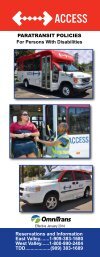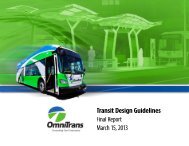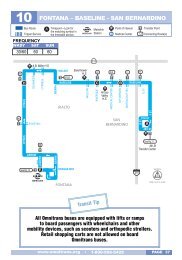New! System-Wide Transit Corridor Plan for the San ... - Omnitrans
New! System-Wide Transit Corridor Plan for the San ... - Omnitrans
New! System-Wide Transit Corridor Plan for the San ... - Omnitrans
Create successful ePaper yourself
Turn your PDF publications into a flip-book with our unique Google optimized e-Paper software.
Chapter 1 – Introduction<br />
appropriately sized street trees in tree<br />
wells at <strong>the</strong> curb<br />
pedestrian-oriented signage<br />
properly scaled street lighting<br />
buildings and <strong>the</strong>ir entrances oriented<br />
toward <strong>the</strong> street<br />
parking behind buildings<br />
traffic calming measures in<br />
neighborhoods adjacent to <strong>the</strong> station<br />
• Well-designed and managed parking, and a<br />
reduction in parking requirements near transit<br />
• A bicycle network and o<strong>the</strong>r non-motor<br />
vehicle modes connecting <strong>the</strong> transit station<br />
with o<strong>the</strong>r transit stops and <strong>the</strong> surrounding<br />
area<br />
• Special attention focused on buildings<br />
designed to enhance <strong>the</strong> pedestrian<br />
environment<br />
SANBAG’s Long Range <strong>Transit</strong> <strong>Plan</strong> contains<br />
regional examples of successful TODs as well as<br />
example policies <strong>for</strong> implementation. <strong>Omnitrans</strong><br />
will work with partner cities to develop supportive<br />
transit plans and policies <strong>for</strong> <strong>the</strong> sbX corridors<br />
and will provide support <strong>for</strong>:<br />
• Updating General <strong>Plan</strong>s<br />
• Preparing Specific <strong>Plan</strong>s<br />
• Preparing Station Area <strong>Plan</strong>s<br />
• Building Community Support<br />
• Urban Design<br />
• Parking Management Strategies<br />
• Zoning<br />
• Af<strong>for</strong>dable Housing<br />
1.8.3 Density Targets<br />
The book, “The <strong>New</strong> <strong>Transit</strong> Town: Best<br />
Practices in <strong>Transit</strong>-Oriented Development,”<br />
describes <strong>the</strong> best practices in TODs. This<br />
source states that <strong>the</strong>re are no absolute densities<br />
<strong>for</strong> a TOD and some of <strong>the</strong> case studies<br />
presented have densities ranging from 10 to 100<br />
dwelling units per acre (DU/AC). Table 1-2 shows<br />
<strong>the</strong> estimated densities of some of <strong>the</strong> examples<br />
of TODs discussed previously.<br />
At densities of around six to seven households<br />
per acre transit use begins to increase and<br />
vehicle trips begin a corresponding decline. At<br />
about 50 households per acre, <strong>the</strong> number of<br />
trips taken daily by vehicles, transit, and walking<br />
become about <strong>the</strong> same. The Urban Land<br />
Institute has developed <strong>the</strong> following minimum<br />
densities <strong>for</strong> supporting transit, shown in Table<br />
1-3.<br />
It is important to note that higher densities and<br />
compact developments indirectly lead to higher<br />
transit ridership and less automobile use. In<br />
mixed use, high density developments, <strong>the</strong><br />
origins and destinations of any given trip are<br />
physically closer. In o<strong>the</strong>r words, goods and<br />
services are closer toge<strong>the</strong>r, resulting in shorter<br />
travel distances and less vehicle miles traveled<br />
(VMT). Studies have shown that employment<br />
densities at trip-destinations have a greater<br />
influence on ridership than do land-use mix and<br />
population densities at trip origins. 1 It is <strong>the</strong>re<strong>for</strong>e<br />
critical to increase development densities and<br />
locate employment opportunities near transit in<br />
order to ensure high TOD ridership.<br />
A person living in a mixed use, high density<br />
development would likely opt <strong>for</strong> a mode of<br />
transit o<strong>the</strong>r than an automobile and instead use<br />
bus, rail, bicycle, or walk. Less VMT means that<br />
<strong>the</strong>re are fewer cars on <strong>the</strong> road, which reduces<br />
energy consumption, decreases air pollution, and<br />
lowers traffic congestion. A <strong>for</strong>thcoming study <strong>for</strong><br />
<strong>Transit</strong> Cooperative Research Program Ensuring<br />
Full Potential Ridership from <strong>Transit</strong>-Oriented<br />
Development (TCRP H-27A) by PB Place<br />
Making, Dr Robert Cervero, The Urban Land<br />
Institute and <strong>the</strong> Center <strong>for</strong> <strong>Transit</strong> Oriented<br />
Development, shows that, on average, TOD<br />
housing produces 50% fewer automobile trips in<br />
<strong>the</strong> four urbanized areas (Philadelphia/N.E. <strong>New</strong><br />
Jersey; Portland, Oregon; metropolitan<br />
Washington D.C.; and <strong>the</strong> East Bay of <strong>the</strong> <strong>San</strong><br />
Francisco Bay Area).<br />
Many cities around <strong>the</strong> United States are looking<br />
to TODs to protect natural resources and<br />
sensitive environmental areas, including mature<br />
established neighborhoods. Growth management<br />
areas and protection zones are often considered<br />
complementary policies and often used in<br />
conjunction with TOD’s to streng<strong>the</strong>n <strong>the</strong> focus of<br />
growth near transit and sustainable<br />
neighborhoods.<br />
1 Cervero, Robert. 2008. Effects of TOD on Housing<br />
Parking and Travel. TCRP Report 128. August 1,<br />
2008.<br />
24 <strong>System</strong>-<strong>Wide</strong> <strong>Transit</strong> <strong>Corridor</strong> <strong>Plan</strong><br />
132














